Resistance bands- also known as exercise bands- come in a variety of colors that look nice. But did you know they serve a function and aren’t just there to look nice? Below, I explain what the colors mean on resistance bands.
The colors on a resistance band indicate their weight. Different colors are used in a coding system to differentiate bands of different strengths. For example, a black band could mean it gives 50lbs of resistance whilst a blue band only gives 20lbs.
I’ve been using bands for over 5 years now.
And one thing I’ve learned is that bands look different because they ARE different. These differences aren’t just there for aesthetic purposes.
This post shares my research and experience on the different resistance band colors and what they mean.
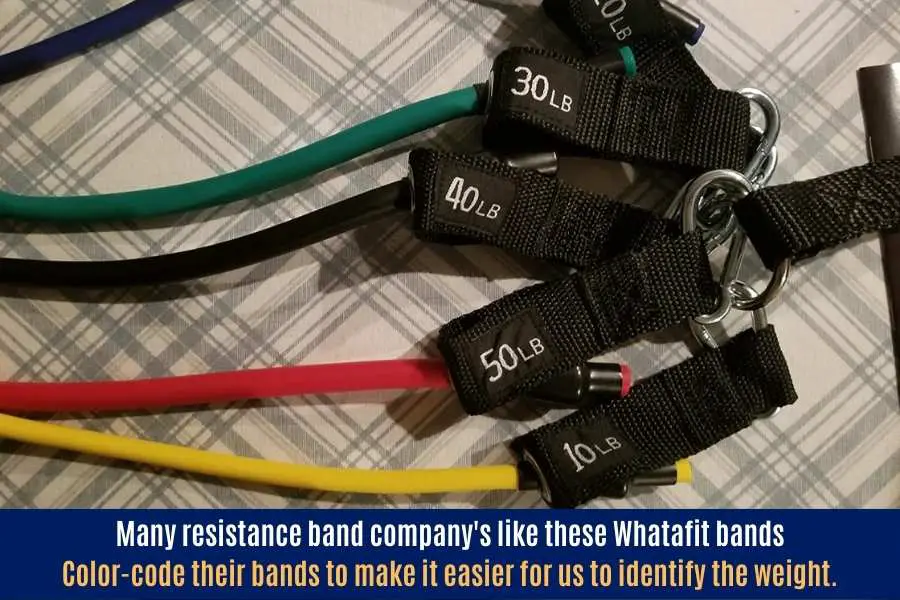
- Resistance Bands Mentioned In This Post
- Why Resistance Bands Have Different Colors
- How Different Band Colors And Weights Affect Function
- The Colors Of Resistance Bands Available
- Deciphering The Color Code For Resistance Bands
- How To Use Colored Resistance Bands
- What Color Resistance Band To Use
- Are Resistance Band Colors Universal?
- Color Of The Strongest And Weakest Resistance Bands
- Where To Find The Bands Mentioned In This Post
- Conclusion
Resistance Bands Mentioned In This Post
| Product | Brand | Description | Prime | Buy |
|---|---|---|---|---|
Top Top
Top
Top
Top
Top
Top | Undersun | BEST OVERALL Circular loop band set with 5x weight increments for beginenrs and advanced lifters to build muscle at home (bundled with door anchor and travel pouch) | PrimeEligible | Check Amazon Price |
 Top
Top
Top
Top
Top
Top Top
Top
Top
Top
Top
Top | Iron Infidel | Circular loop band set with 5x weight increments. No door anchor and less durable than Undersun. But a portion of their profits is donated to the Wounded Warriors Foundation for injured war veterans | PrimeEligible | Check Amazon Price |
 Top
Top
Top
Top
Top
Top Top
Top
Top
Top
Top
Top | WODFitters | Budget circular loop bands that can be purchased as single bands | PrimeEligible | Check Amazon Price |
 Top
Top
Top
Top
Top
Top Top
Top
Top
Top
Top
Top | Whatafit | BEST BUDGET tube bands with handles. Cheap and affordable for beginenrs but do not provide the same weight or durability as circular loop bands. | PrimeEligible | Check Amazon Price |
 | Theraband | Alternative bands for seniors. Extremely affordable but light resistance bands for general fitness workouts. | PrimeEligible | Check Amazon Price |
 Top
Top
Top
Top
Top
Top Top
Top
Top
Top
Top
Top | Boss Fitness | Door anchor replacement for unlocking exercise angles to isolate different muscle regions like the upper chest | PrimeEligible | Check Amazon Price |
 Top
Top
Top
Top
Top
Top Top
Top
Top
Top
Top
Top | Ihuan | Ventilated microfibre-neoprene workout gloves to protect hands from friction burns generated by resistance bands | PrimeEligible | Check Amazon Price |
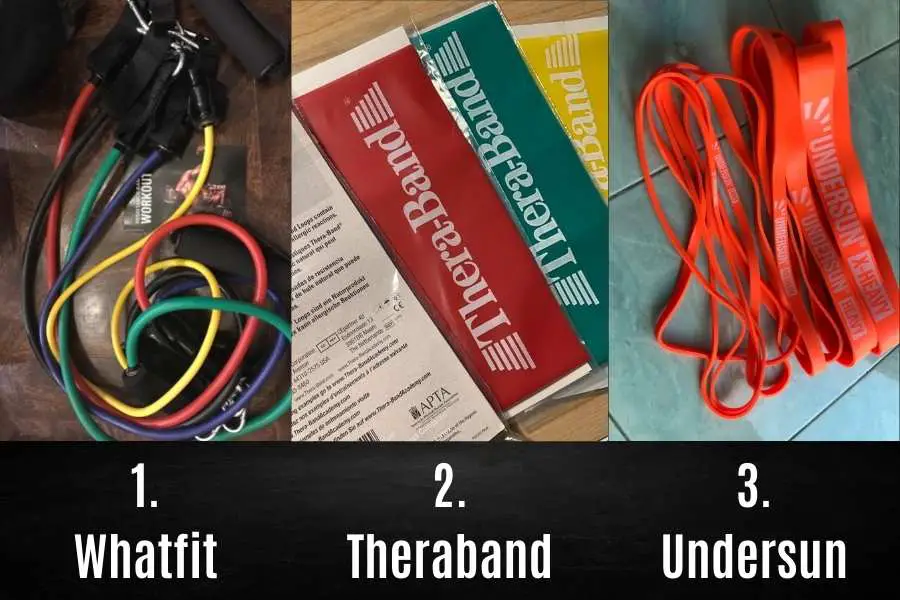
- Whatafit resistance band set (link for the cheapest price). Best-selling colored resistance band set on Amazon that uses a popular color scheme (blue, yellow, green, black, red). Good for beginners to intermediates.
- Theraband set (link for the cheapest price). Long-standing resistance band company that uses an alternate color scheme aimed at beginners and the elderly.
- Undersun resistance band set (link for the cheapest price). My recommendation (I have been using these for 2 years now). Weights are labeled instead of color-coded. Good for intermediates to advanced.
Why Resistance Bands Have Different Colors
Resistance bands are made in different colors for identification. A band set usually features a variety of strength increments each of which has a different weight. Color-coding makes it easier for the user to quickly and accurately choose the desired weight.
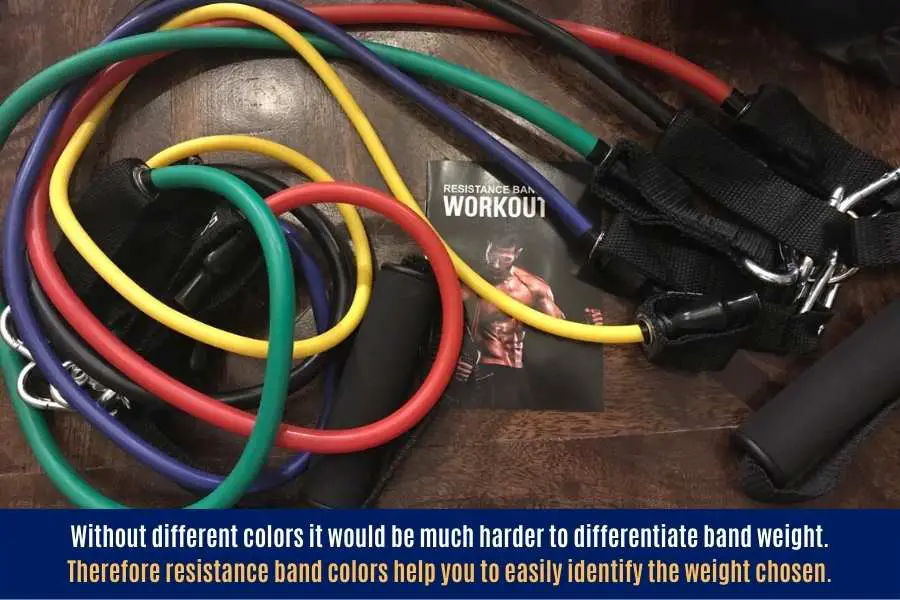
If you’ve ever used resistance bands before, you’ll know that they come in a variety of shapes, sizes, and strength levels.
You can check out this post for more information on the different shapes of resistance bands.
But for now, let’s focus on the different band strengths and why they exist.
How Different Band Colors And Weights Affect Function
Different band strengths have different properties as follows:
- High-strength heavy bands are less stretchy and harder to elongate.
- Low-strength light bands are more stretchy and easier to elongate.
These properties allow you to change exercise intensity by simply switching the band.
This in turn allows you to progress through a spectrum of weights as you become stronger.
Additionally, different band weights are suited to different exercises.
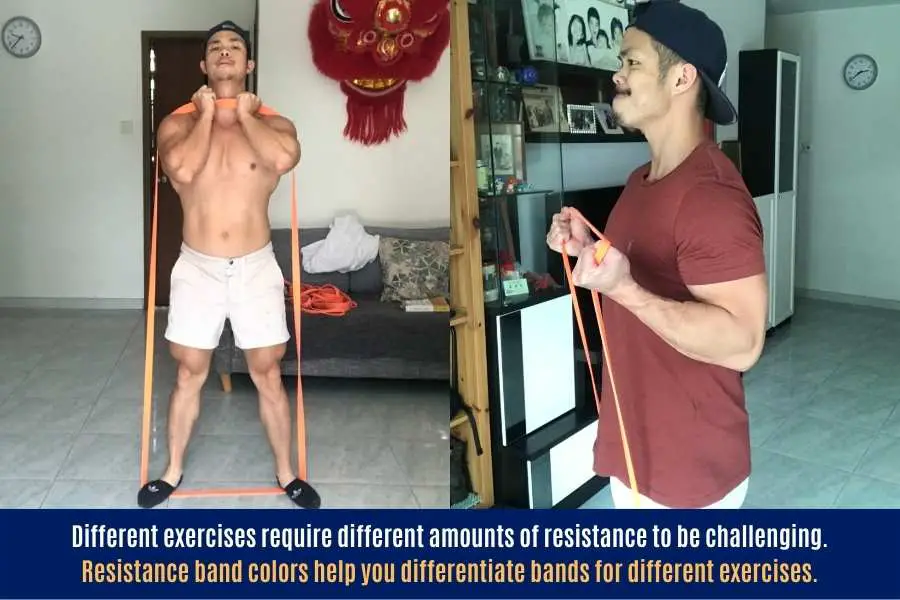
For example, light bands are great for isolation-type movements like the bicep curl which does not require much resistance to challenge the biceps.
In contrast, heavy bands are more suitable for compound-type movements like the squat which requires more resistance to effectively challenge the larger leg muscles.
Now that you know this, you can probably see a problem here.
How can we easily and accurately identify which resistance band is what weight? After all, one resistance band doesn’t look visually all too different from the next band, right?
Through a color-coded system of course!
Manufacturers assign different resistance band weights with colors to make it easier for us to tell what band strength we are using.
The Colors Of Resistance Bands Available
Popular resistance band colors include yellow, blue, green, black, and red. However, different manufacturers may vary their color code. Other colors used by resistance band companies include gold, silver, tan, purple, pink, and orange.
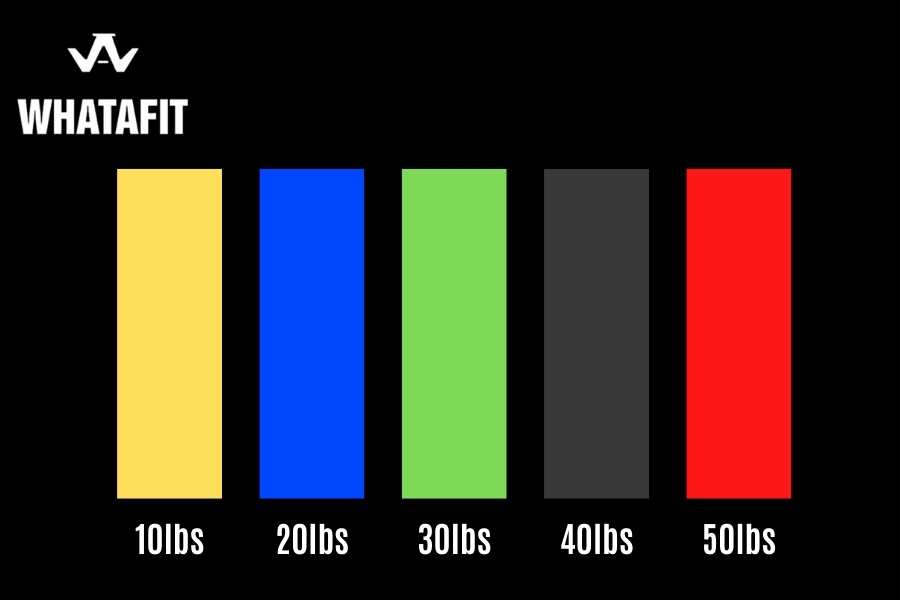
For example; do a quick search on Amazon and you’ll see that many of the best-selling brands exclusively use the following colors:
- Yellow.
- Blue.
- Green.
- Black.
- Red.
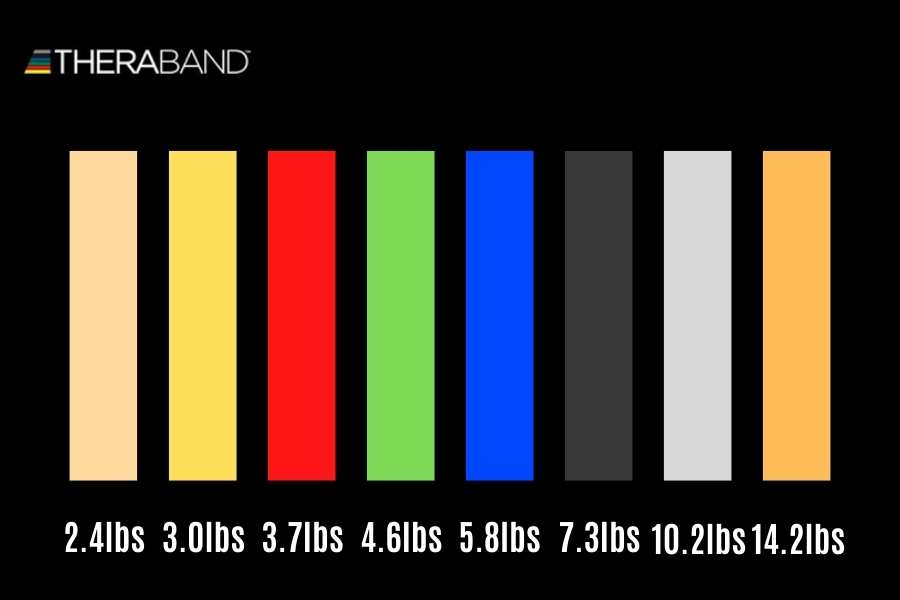
However, there are also certain brands like Theraband and Sunpow that deviate from this standard color code and also use the following quirkier colors:
- Gold.
- Silver.
- Tan.
- Purple.
- Grey.
- Pink.
- Orange.
Thus, each resistance band color represents a different weight.
And each manufacturer is slightly different with regards to their color code.
However, they all share one thing in common; the color-coding system is there to make the bands visually distinguishable and differentiable.
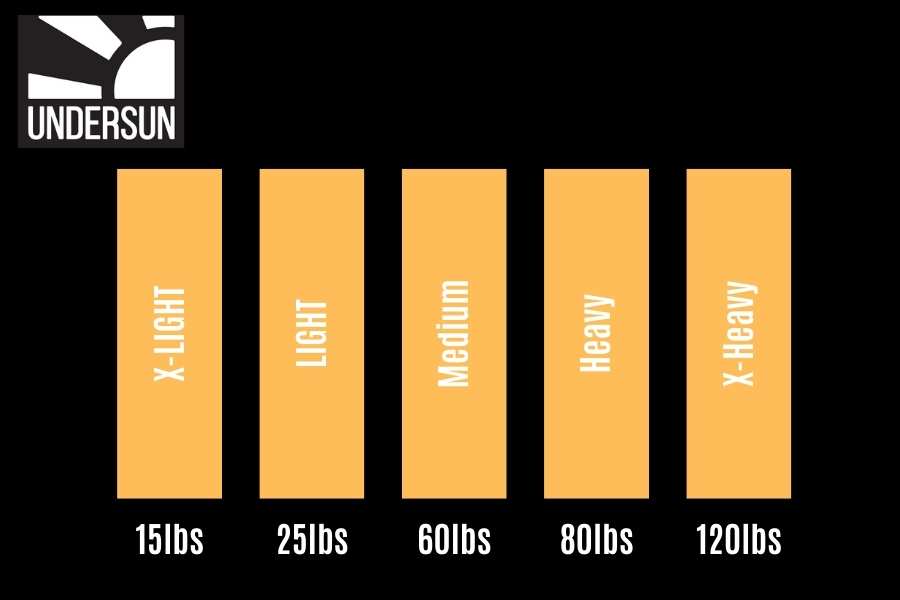
Some companies like Undersun Fitness may even opt to make their resistance bands the same color and label them with their respective weight instead.
It’s usually circular loop-style bands (not tube-style bands with handles) that use this coding system.
Here, the different weight increments are usually more identifiable without a color-coding since each band differs significantly in thickness and width.
Deciphering The Color Code For Resistance Bands
The resistance band color code is unique for each manufacturer. This means different brands can make their resistance bands in different colors. However, a popular color-coding scheme is 10-50lbs in 10lb increments for yellow, blue, green, black, and red bands.
For example, here is the color-code scheme followed by Whatafit which is a popular brand:
| Resistance Band Color | Typical Weight Classification | Typical Lbs |
|---|---|---|
| Yellow | Extra-light | 10lbs |
| Blue | Light | 20lbs |
| Green | Medium | 30lbs |
| Black | Heavy | 40lbs |
| Red | Extra-heavy | 50lbs |
Even though color codes are different between manufacturers, the above scheme is commonly used due to the visually stark differences between each color.
As such, it’s a popular color scheme adopted by many companies.
However, other companies like Theraband use a much different color code:
| Theraband Color | Weight Classification | Lbs |
|---|---|---|
| Tan | Lightest | 2.4lbs |
| Yellow | Extra-light | 3.0lbs |
| Red | Light | 3.7lbs |
| Green | Medium-light | 4.6lbs |
| Blue | Medium | 5.8lbs |
| Black | Medium-heavy | 7.3lbs |
| Silver | Heavy | 10.2lbs |
| Gold | Extra-heavy | 14.2lbs |
This begs the question; how do you tell the color code for resistance bands?
Thankfully, the manufacturers make it easy for us.
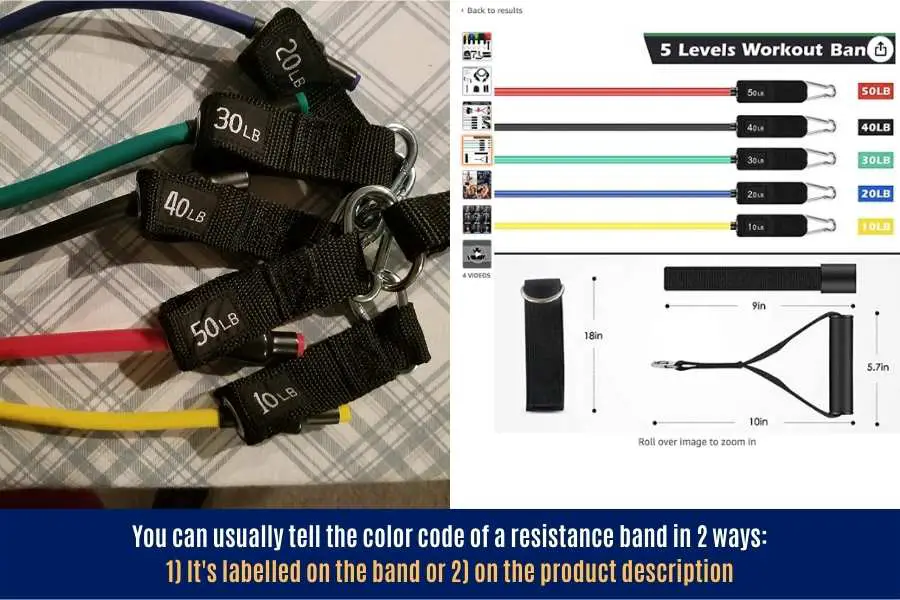
The color code is usually signified in one of two ways:
- Labeled on the band. The weight is clearly marked usually on the band itself or the handle.
- Product description. The color code will be available on the manufacturer’s website’s product profile.
Now that you know what the colors mean on resistance bands, it’s time to find out how to use colored resistance bands!
If you don’t know what is meant by a 10lb band, 20lbs band, etc, then you might want to check out my other post which explains what the weight means on resistance bands!
How To Use Colored Resistance Bands
Colored resistance bands are used just like any other band. A suitable weight is chosen and the band is anchored to a secure mount. This allows the user to push or pull on the band in a variety of exercises to target different muscles in the body.

Something you may have noticed is that resistance bands come in a variety of shapes.
But they are all roughly categorized as circular loop-style or tube-style with handles.
Both types of resistance bands are used in the same way.
You anchor them to your body (e.g. the feet) or an external mount (e.g. a door anchor).
Now you can perform a variety of resistance band exercises such as:
| Band Exercise | Target Muscles | Recommended Beginners Color | Band Weight |
|---|---|---|---|
| Chest press | Pectorals, deltoids, triceps | Green | 30lbs |
| Pec fly | Pectorals, biceps | Blue | 20lbs |
| Shoulder press | Deltoids, triceps, pectorals | Green | 30lbs |
| Lateral raise | Deltoids | Yellow | 10lbs |
| Back row | Trapezius, latissimus dorsi, rhomboids, biceps. | Green | 30lbs |
| Reverse fly | Trapezius, latissimus dorsi, rhomboids | Yellow | 10lbs |
| Ab crunch | Abdominals, obliques | Blue | 20lbs |
| Core rotation | Abdominals, obliques | Blue | 20lbs |
| Tricep extension | Triceps | Blue | 20lbs |
| Bicep curl | Biceps | Blue | 20lbs |
| Squat | Quadriceps, hamstrings, calves, glutes | Black | 40lbs |
| Deadlift | Full-body | Red | 50lbs |
If you’re interested in learning how to perform the above exercises (and more), you can check out my other post which explains how beginners can use resistance bands.
What Color Resistance Band To Use
Resistance band color should be chosen according to goals and abilities. Beginners and people who are training for cardio or fat-burning should use a lighter-colored band. Intermediates and people who are training for muscle and strength gains should use heavier-colored bands.
Thus, different colored bands and weights have different applications.
If we use the popular Whatfit color code (see previous) as an example, here’s how to choose the ideal resistance band color:
| Resistance Band Color | Weight | Ideal Training Level | Ideal Goal |
|---|---|---|---|
| Yellow | 10lbs | Beginner | Cardio |
| Blue | 20lbs | Novice | Fat-burning |
| Green | 30lbs | Intermediate | All-purpose |
| Black | 40lbs | Intermediate-advanced | Increasing muscle tone |
| Red | 50lbs | Advanced | Building strength and muscle |
Note, that these are very generalized recommendations. In reality, each band color has a spectrum of uses.
See below for more detailed recommendations.
Extra-light bands:
- Ideal for beginners who have just started resistance band training.
- Can also be used by intermediates and advanced lifters for warming up.
- Work well with small isolation-type movements bicep curls, lateral raises, tricep extensions, and ab crunches.
- Great for using in high-rep cardio workouts.
- Often used by physiotherapists for their patients or by the elderly.
Light bands:
- Ideal for novices who have been using resistance bands for 1-3 months.
- Popular color for novices to perform compound movements like squats, lunges, presses, rows, and deadlifts.
- Can also be used by intermediates and advanced lifters for small-isolation type movements like bicep curls.
- Great for burning fat but can also be used by novices to increase muscle definition.
- Commonly used for post-injury rehabilitation.
Medium bands:
- Ideal for intermediates who have been using resistance bands for 6-12 months.
- Popular color for intermediates to perform compound movements like squats, lunges, presses, rows, and deadlifts.
- Can also be used by novices for an extra-challenging workout or by advanced lifters for small-isolation type movements.
- Great all-purpose band color for building muscle, losing fat, and increasing tone.
- Commonly used at all training levels.
Heavy bands:
- Ideal for intermediate-advanced lifters who have been band training for 12-18 months.
- Popular color for heavy compound exercises to build muscle.
- Great for increasing muscle size and tone.
- Often found in gyms for those interested in building muscle.
Extra-heavy bands:
- Ideal for advanced lifters who have been working with bands for 24+ months.
- Popular color for people interested in building maximum muscle and strength.
- Mainly used for the main compound lifts (squat, deadlift, bench press, row, shoulder press).
- Great for increasing full-body muscle size and power.
- Often found in commercial gyms.
New to band workouts? Don’t overtrain! You can check out my other post to find out why it’s not OK to use resistance bands everyday.
Are Resistance Band Colors Universal?
Resistance band colors are not universal. Although yellow, blue, green, black, and red are popularly used by many different manufacturers, these are not standard colors. Some manufacturers may choose to use a different color scheme.
I thought it necessary to highlight this point.
Each company uses its color code!
It just so happens to be that yellow, blue, green, black, and red are popular color schemes due to the stark visual differences.
It would make sense to use colors that looked similar right?
That would defeat the purpose of using a color scheme in the first place…

It should also be noted that two brands can have the same color scheme but a different color code.
By that, I mean one company might use black to identify their heavy band but another company may use the same color to identify their light band.
So please be careful and check the color and weight of your bands.
The last thing you want is to buy the wrongly sized bands.
This could render your workouts ineffective or even impossible to perform!
Color Of The Strongest And Weakest Resistance Bands
The strongest and hardest resistance band color is usually red or black. In contrast, the weakest and easiest resistance band color is usually yellow or blue. But colors are not universal and different brands may deviate from this trend.
Speaking from personal experience and research, oftentimes the heaviest bands are red or black. And the lightest bands are often yellow or blue.
But as I mentioned before; resistance band colors are not universal.
So although this is a common trend, it’s not always the case.
Always do your own research and don’t just assume the weight of a certain band color!
If you’re not sure what resistance band weight classifications are, you can check out my other post which explains the weight of a heavy, medium, and light resistance band.
Where To Find The Bands Mentioned In This Post
You can buy direct from the manufacturer.
But in my experience, Amazon offers the fastest and cheapest option overall (including delivery).
Here are the cheapest places I found the resistance bands mentioned in this post:
| Product | Brand | Description | Prime | Buy |
|---|---|---|---|---|
Top Top
Top
Top
Top
Top
Top | Undersun | BEST OVERALL Circular loop band set with 5x weight increments for beginenrs and advanced lifters to build muscle at home (bundled with door anchor and travel pouch) | PrimeEligible | Check Amazon Price |
 Top
Top
Top
Top
Top
Top Top
Top
Top
Top
Top
Top | Iron Infidel | Circular loop band set with 5x weight increments. No door anchor and less durable than Undersun. But a portion of their profits is donated to the Wounded Warriors Foundation for injured war veterans | PrimeEligible | Check Amazon Price |
 Top
Top
Top
Top
Top
Top Top
Top
Top
Top
Top
Top | WODFitters | Budget circular loop bands that can be purchased as single bands | PrimeEligible | Check Amazon Price |
 Top
Top
Top
Top
Top
Top Top
Top
Top
Top
Top
Top | Whatafit | BEST BUDGET tube bands with handles. Cheap and affordable for beginenrs but do not provide the same weight or durability as circular loop bands. | PrimeEligible | Check Amazon Price |
 | Theraband | Alternative bands for seniors. Extremely affordable but light resistance bands for general fitness workouts. | PrimeEligible | Check Amazon Price |
 Top
Top
Top
Top
Top
Top Top
Top
Top
Top
Top
Top | Boss Fitness | Door anchor replacement for unlocking exercise angles to isolate different muscle regions like the upper chest | PrimeEligible | Check Amazon Price |
 Top
Top
Top
Top
Top
Top Top
Top
Top
Top
Top
Top | Ihuan | Ventilated microfibre-neoprene workout gloves to protect hands from friction burns generated by resistance bands | PrimeEligible | Check Amazon Price |
Conclusion
I’ve explained what the colors mean on resistance bands.
The color code is a simple way for manufacturers to differentiate the weights, tensions, and strengths of their bands.
This makes it easier for users to identify the weight of the resistance band we are lifting.
A popular color scheme used by many different companies is yellow, blue, green, black, and red (due to the visually stark palette).
But some companies may use additional colors like tan, gold, silver, etc).
Some companies may even use the same color for all their bands and simply choose to label them using the words “heavy”, “medium”, “light”, etc.
Thus, resistance band color codes are not universal.
So make sure you check carefully!
What color code are your bands?
Feel free to send me a message if you have any questions! You can find my details on the “contact us” page.
You may also be interested in the downloadable Kalibre Blueprint PDF which details exactly how I gained 40lbs of lean muscle (it’s 100% free!). It details the exact exercises and nutrition (with printable worksheets) I used to go from skinny to ripped!
Thanks for reading guys!
Peace Out,
Kal
(Biochemistry BSc, Biomedical Sciences MSc, Ex-Skinny Guy)


